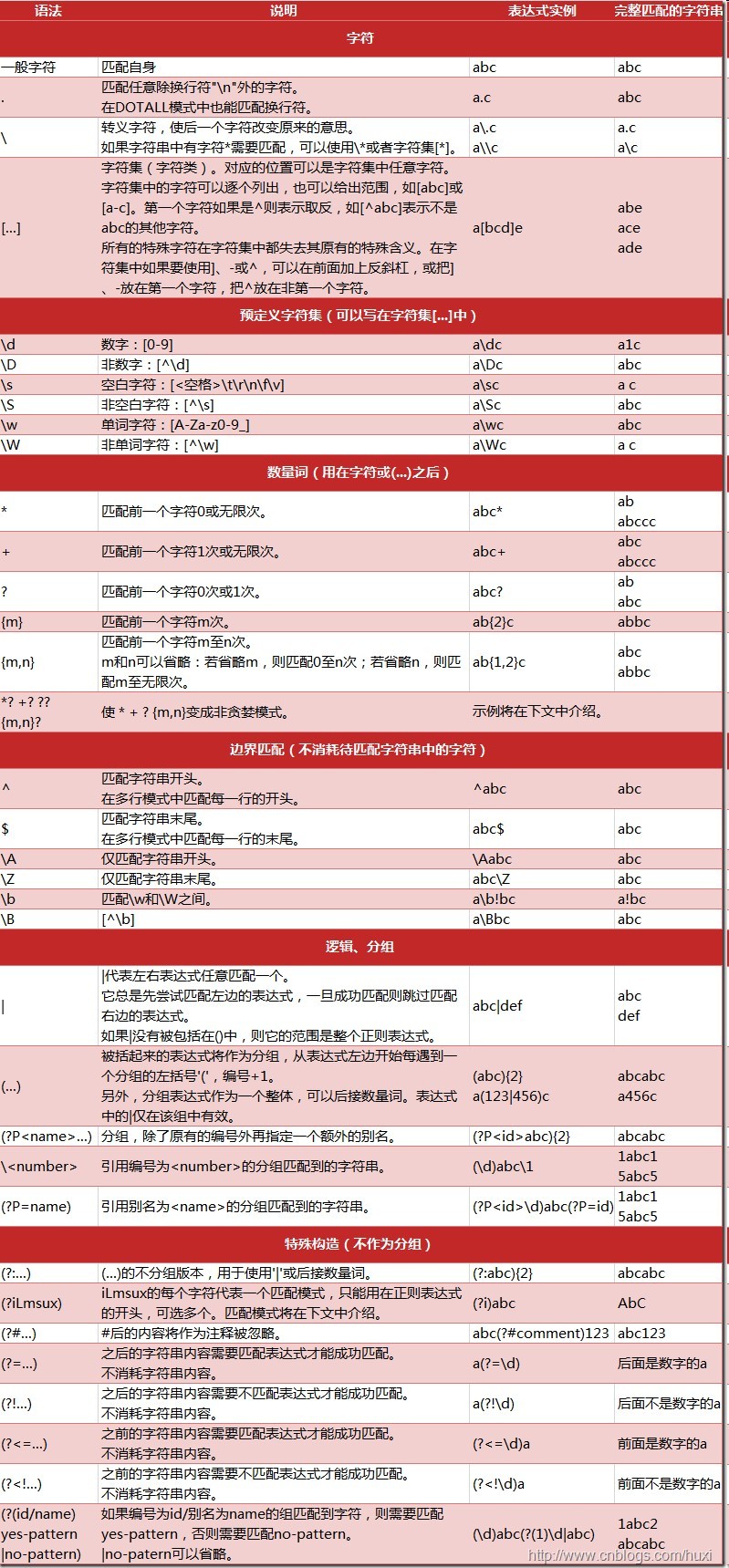Python正则表达式
正则表达式是处理字符串的强大工具,拥有独特的语法和独立的处理引擎。
我们在大文本中匹配字符串时,有些情况用str自带的函数(比如index, find, in)可能可以完成,有些情况会稍稍复杂一些(比如说找出所有“像邮箱”的字符串,所有和xiniuedu/netease相关的句子),这个时候我们需要一个某种模式的工具,这个时候正则表达式就派上用场了。
自然语言处理的各种模型和算法要发挥作用离不开数据,离不开“干净”的数据,而现实生活中的数据形态和干净程度不一,我们经常要做一些数据清洗和信息抽取的工作,这时候正则表达式就可以发挥及其强大的匹配功能了。说起来,正则表达式是一套引擎,并不是Python语言独有的功能或者工具库,下面我们就来了解一下正则表达式吧。
1.学习与验证工具
我们最喜爱的正则表达式在线验证工具之一是http://regexr.com/ ,大家可以在线的方式学习与验证正则表达式的对错,左边还有对应的工具和速查表。

2.正则表达式语法
下面是一张有些同学比较熟的图,我们俗称python正则表达式小抄,大家可以遵循一般字符、预定义字符集、数量词、边界匹配、逻辑分组 和 特殊构造的逻辑去逐步学习。
当你要匹配 一个/多个/任意个 数字/字母/非数字/非字母/某几个字符/任意字符,想要 贪婪/非贪婪 匹配,想要捕获匹配出来的 第一个/所有 内容的时候,记得这里有个小手册供你参考。

3.挑战与提升
长期做自然语言处理的同学正则表达式都非常熟,在若干年前硕士刚毕业时曾有一段时间写了大量的正则表达式,以至于同事间开玩笑说,只要是符合某种规律或者模式的串,肯定分分钟能匹配出来。正则表达式属于“短时间内习得且受益终身的技能”
对于想练习正则表达式,或者短期内快速get复杂技能,or想挑战更复杂的正则表达式的同学们。
请戳正则表达式进阶练习
各位宝宝enjoy yourself

4.Python案例
re模块
Python通过re模块提供对正则表达式的支持。
使用re的一般步骤是
- 1.将正则表达式的字符串形式编译为Pattern实例
- 2.使用Pattern实例处理文本并获得匹配结果(一个Match实例)
- 3.使用Match实例获得信息,进行其他的操作。
1 | # encoding: UTF-8 |
hello, pastor!
re.compile(strPattern[, flag]):
这个方法是Pattern类的工厂方法,用于将字符串形式的正则表达式编译为Pattern对象。
第二个参数flag是匹配模式,取值可以使用按位或运算符’|’表示同时生效,比如re.I | re.M。
当然,你也可以在regex字符串中指定模式,比如re.compile(‘pattern’, re.I | re.M)等价于re.compile(‘(?im)pattern’)
flag可选值有:
- re.I(re.IGNORECASE): 忽略大小写(括号内是完整写法,下同)
- re.M(MULTILINE): 多行模式,改变’^’和’$’的行为(参见上图)
- re.S(DOTALL): 点任意匹配模式,改变’.’的行为
- re.L(LOCALE): 使预定字符类 \w \W \b \B \s \S 取决于当前区域设定
- re.U(UNICODE): 使预定字符类 \w \W \b \B \s \S \d \D 取决于unicode定义的字符属性
- re.X(VERBOSE): 详细模式。这个模式下正则表达式可以是多行,忽略空白字符,并可以加入注释。以下两个正则表达式是等价的:
1 | regex_1 = re.compile(r"""\d + # 数字部分 |
Match
Match对象是一次匹配的结果,包含了很多关于此次匹配的信息,可以使用Match提供的可读属性或方法来获取这些信息。
match属性:
- string: 匹配时使用的文本。
- re: 匹配时使用的Pattern对象。
- pos: 文本中正则表达式开始搜索的索引。值与Pattern.match()和Pattern.seach()方法的同名参数相同。
- endpos: 文本中正则表达式结束搜索的索引。值与Pattern.match()和Pattern.seach()方法的同名参数相同。
- lastindex: 最后一个被捕获的分组在文本中的索引。如果没有被捕获的分组,将为None。
- lastgroup: 最后一个被捕获的分组的别名。如果这个分组没有别名或者没有被捕获的分组,将为None。
方法:
- group([group1, …]):
获得一个或多个分组截获的字符串;指定多个参数时将以元组形式返回。group1可以使用编号也可以使用别名;编号0代表整个匹配的子串;不填写参数时,返回group(0);没有截获字符串的组返回None;截获了多次的组返回最后一次截获的子串。 - groups([default]):
以元组形式返回全部分组截获的字符串。相当于调用group(1,2,…last)。default表示没有截获字符串的组以这个值替代,默认为None。 - groupdict([default]):
返回以有别名的组的别名为键、以该组截获的子串为值的字典,没有别名的组不包含在内。default含义同上。 - start([group]):
返回指定的组截获的子串在string中的起始索引(子串第一个字符的索引)。group默认值为0。 - end([group]):
返回指定的组截获的子串在string中的结束索引(子串最后一个字符的索引+1)。group默认值为0。 - span([group]):
返回(start(group), end(group))。 - expand(template):
将匹配到的分组代入template中然后返回。template中可以使用\id或\g、\g 引用分组,但不能使用编号0。\id与\g 是等价的;但\10将被认为是第10个分组,如果你想表达\1之后是字符’0’,只能使用\g<1>0。
1 | import re |
m.string: hello pastor!
m.re: <_sre.SRE_Pattern object at 0x10b111be0>
m.pos: 0
m.endpos: 18
m.lastindex: 3
m.lastgroup: sign
m.group(1,2): ('hello', 'pastor')
m.groups(): ('hello', 'pastor', '!')
m.groupdict(): {'sign': '!'}
m.start(2): 6
m.end(2): 17
m.span(2): (6, 17)
m.expand(r'\2 \1\3'): pastor hello!
Pattern
Pattern对象是一个编译好的正则表达式,通过Pattern提供的一系列方法可以对文本进行匹配查找。
Pattern不能直接实例化,必须使用re.compile()进行构造。
Pattern提供了几个可读属性用于获取表达式的相关信息:
- pattern: 编译时用的表达式字符串。
- flags: 编译时用的匹配模式。数字形式。
- groups: 表达式中分组的数量。
- groupindex: 以表达式中有别名的组的别名为键、以该组对应的编号为值的字典,没有别名的组不包含在内。
1 | import re |
p.pattern: (\w+) (\w+)(?P<sign>.*)
p.flags: 16
p.groups: 3
p.groupindex: {'sign': 3}
使用pattern
- match(string[, pos[, endpos]]) | re.match(pattern, string[, flags]):
这个方法将从string的pos下标处起尝试匹配pattern:- 如果pattern结束时仍可匹配,则返回一个Match对象
- 如果匹配过程中pattern无法匹配,或者匹配未结束就已到达endpos,则返回None。
- pos和endpos的默认值分别为0和len(string)。
注意:这个方法并不是完全匹配。当pattern结束时若string还有剩余字符,仍然视为成功。想要完全匹配,可以在表达式末尾加上边界匹配符’$’。
- search(string[, pos[, endpos]]) | re.search(pattern, string[, flags]):
这个方法从string的pos下标处起尝试匹配pattern- 如果pattern结束时仍可匹配,则返回一个Match对象
- 若无法匹配,则将pos加1后重新尝试匹配,直到pos=endpos时仍无法匹配则返回None。
- pos和endpos的默认值分别为0和len(string))
1 | # encoding: UTF-8 |
pastor
- split(string[, maxsplit]) | re.split(pattern, string[, maxsplit]):
- 按照能够匹配的子串将string分割后返回列表。
- maxsplit用于指定最大分割次数,不指定将全部分割。
1 | import re |
['one', 'two', 'three', 'four', '']
- findall(string[, pos[, endpos]]) | re.findall(pattern, string[, flags]):
- 搜索string,以列表形式返回全部能匹配的子串。
1 | import re |
['1', '2', '3', '4']
- finditer(string[, pos[, endpos]]) | re.finditer(pattern, string[, flags]):
- 搜索string,返回一个顺序访问每一个匹配结果(Match对象)的迭代器。
1 | import re |
1
2
3
4
- sub(repl, string[, count]) | re.sub(pattern, repl, string[, count]):
- 使用repl替换string中每一个匹配的子串后返回替换后的字符串。
- 当repl是一个字符串时,可以使用\id或\g
、\g 引用分组,但不能使用编号0。 - 当repl是一个方法时,这个方法应当只接受一个参数(Match对象),并返回一个字符串用于替换(返回的字符串中不能再引用分组)。
count用于指定最多替换次数,不指定时全部替换。
- 当repl是一个字符串时,可以使用\id或\g
- 使用repl替换string中每一个匹配的子串后返回替换后的字符串。
1 | import re |
say i, pastor hello!
I Say, Hello pastor!
- subn(repl, string[, count]) |re.sub(pattern, repl, string[, count]):
- 返回 (sub(repl, string[, count]), 替换次数)。
1 | import re |
('say i, pastor hello!', 2)
('I Say, Hello pastor!', 2)
